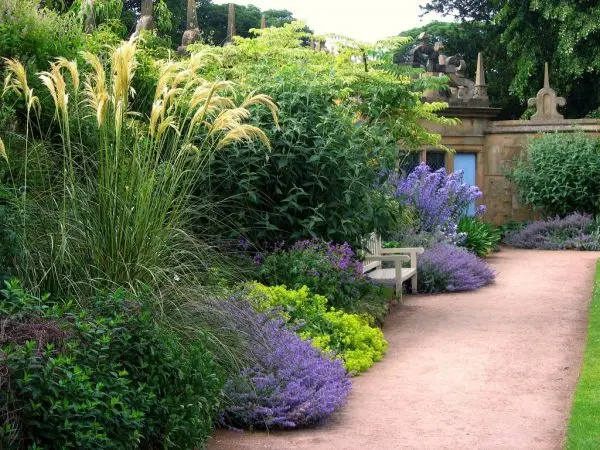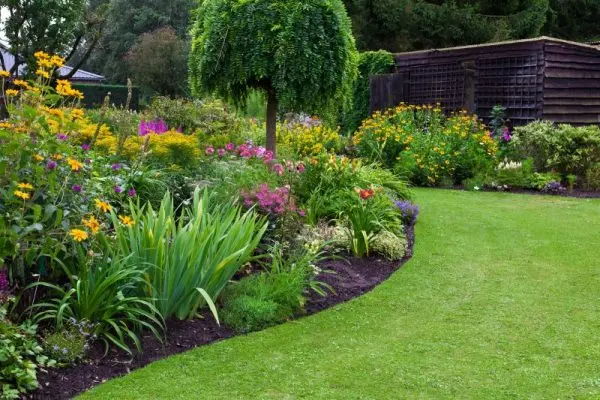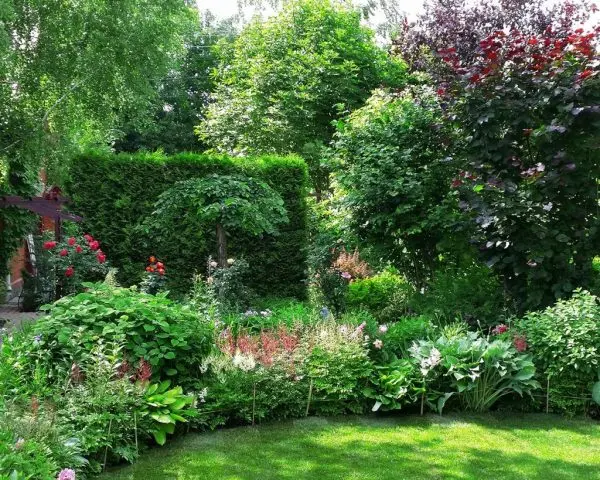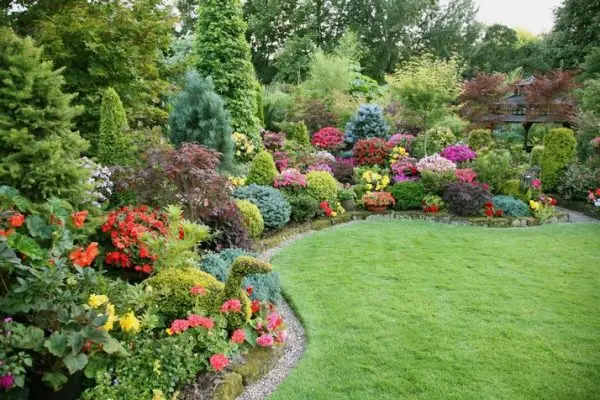Contents
In the life of every gardener, there comes a moment when you want to try something new, to make everything even better. In such cases, you can quench the creative itch by transplanting a flower bed, but it usually helps for a short time. And then the thought comes to mind – “We need to make a mixborder!”. The idea is wonderful, especially since it is not so easy to make mixborders from perennials and shrubs. In this article, we will look at what plants, types of shrubs and schemes are used to create a mixborder.
What is it
Mixborder – a special combination of different plants to create the effect of continuous flowering. The name is derived from the English words mix – mix and border – border. The basis for planting is perennial plants, some types of ornamental shrubs; annual and biennial flowers, herbs are used as an additional decoration. There is a formula by which the size of the mixborder is calculated – the width should not exceed 2 times the height of the tallest plant.

At its core, the main task when creating a mixborder is to pick up plants that will bloom one after another. The catch, usually, is that plants that have already faded do not spoil the appearance of the composition later. Difficulties await the gardener not only at the stage of creation, but also when caring for the composition. Mixborders of perennials must be: regularly watered in accordance with the wishes of flowers, shrubs, herbs; cut to prolong flowering, or remove a defect; fertilize, carry out disease prevention; transplant on time.
Video “Mixborder do-it-yourself”
This video presents a selection of how to create mixborders using shrubs and various flowers.
Layout
The main difference between a mixborder and ordinary borders, ridges and alpine slides is the dense planting of plants, they seem to flow one into another. At the same time, do not forget about the basis, so to speak, the skeleton, landing. Tall shrubs or trees act as the backbone. The planning can be divided into three major stages:
- Soil preparation, planting outline. For example, divide the chosen place into 3-4 unequal zones. In the background there will be lush bushes, trees. Flowers or herbs with tall stems are brought to the middle plan. Next are medium-sized varieties. In the foreground, undersized and ground cover flowers are comfortably located.

- Elaboration of the semantic load of the mixborder. That is, the definition of its function in the garden: decorating artificial reservoirs, stairs, garden paths, or ennobling the porch of a house.
- Landing height and viewing angle. It is important to determine the upper growth limit of the selected plants in order to accurately match the transition patterns. If the plants “interrupt” each other, it will turn out ugly. It is also important to decide on the viewing angle so that it does not accidentally turn out to be “backward” to garden visitors.
For the convenience of further analysis of the plan, give the code names for each zone. Having finished with the layout, you can start choosing colors that will create the basis for the composition.
Choice of colors
There are some useful guidelines when choosing colors for a mixborder. First, you should not densely plant perennials prone to overgrowth. Secondly, do not abuse bearded irises – after flowering they will spoil the appearance of the planting. The following shrubs and ornamental trees are suitable for the green base of the composition:
- boxwood;
- Lawson’s cypress;
- Bergman’s pine;
- juniper scaly;
- spirea;
- scapula;
- Chubushnik;
- willow;
- viburnum.

If desired, you can supplement or replace the above types in order to get not only lush greenery in the background, but also beautiful, expressive flowers:
- Meyer’s lilac;
- magnolia;
- jasmine;
- hydrangea;
- elder;
The following plants are suitable for the middle and foreground:
- phlox;
- spray and creeping types of roses;
- delphinium;
- asters;
- heichera;
- tulips;
- hyacinths;
- violets;
- bells;
- hybrid carnation;
- irises;
- lilies;
- eustoma.
Herbs will help to complement the composition. On the one hand, they will provide a natural cushion of greenery for low and medium-sized flowers, and on the other hand, they will add fresh notes to the aroma created by the mixborder. In addition, some medicinal herbs can later be used for home preparations.
Pay attention to:
- saffron;
- mountain arnica;
- Althaea officinalis;
- oregano;
- calendula;
- plantain;
- thyme;
- medicinal sage;
- medicinal wormwood.

Step by step arrangement
The schemes for creating a mixborder are numerous and, in fact, are limited only by your patience and capabilities. Having decided which plants you want to see in the composition, having drawn a planting plan, you can begin to realize your fantasies. First of all, start planting trees and shrubs, according to the plan. They should be planted at different distances, so that there is room for plants of the middle and foreground.
This asymmetry will help refresh the look, and also give room to fill niches. The second stage is the planting of tall and medium-sized perennials. When planting them, keep an eye on the density of plants so that those that tend to grow have a small space around for this.
The third stage is bulbous plants. It is they who play the role of a bright element in the middle plan of the mixborder. During the flowering period (different types of bulbs bloom from early spring to early autumn), they will fill the gaps with their flowers, and since the composition involves a combination of flowers from different flowering periods, continuous flowering will result.

The fourth stage is planting flowers and herbs in the foreground. It is here that ground cover and undersized flowers will be located, forming a flowering carpet. In the foreground, you can put not only perennial flowers, add annual varieties to refresh the look of the mixborder every year. Do not be afraid to experiment with the content, shape and look of the mixborder. And also be patient, because such beauty grows for a long time.
Video “Creating a mixborder”
A step-by-step guide to creating an original mixborder on a garden plot with your own hands.









